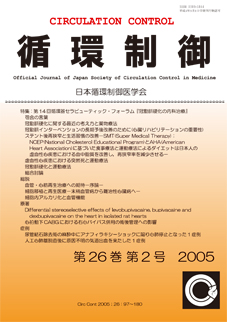Volume 26, Issue 2
Displaying 1-4 of 4 articles from this issue
- |<
- <
- 1
- >
- >|
original articles
-
2005Volume 26Issue 2 Pages 140-147
Published: 2005
Released on J-STAGE: July 07, 2006
Download PDF (155K) -
2005Volume 26Issue 2 Pages 148-151
Published: 2005
Released on J-STAGE: July 07, 2006
Download PDF (49K)
case reports
-
2005Volume 26Issue 2 Pages 152-155
Published: 2005
Released on J-STAGE: July 07, 2006
Download PDF (38K) -
2005Volume 26Issue 2 Pages 156-158
Published: 2005
Released on J-STAGE: July 07, 2006
Download PDF (41K)
- |<
- <
- 1
- >
- >|
